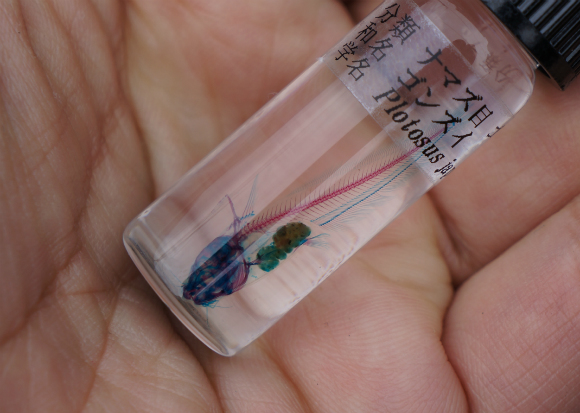
Have you heard of a series of unique creations called “Transparent Specimens” produced by Iori Tomita? It may sound bizarre, but they are specimens of different living creatures including fish, arthropods, reptiles and mammals that have been specially treated to make them transparent. And the end result is far from bizarre – in fact, the specimens are so beautiful that the series of work have a considerable following of fans.
The picture below is a transparent specimen of plotosus – a kind of catfish – which I purchased at a Tokyu Hands store in Tokyo for about 2,900yen (approx. $36). The contrasting blue, purple, red and green colors are breathtaking, and every detail down to each bone can be clearly seen. I have to say that this is the most beautiful scientific specimen I have ever seen.
But how do you make something that looks so unusual and striking? I asked the staff at Tokyu Hands and was able to find out the following:
【How to create a “transparent specimen”】
1. Immerse the fish in formalin and fix the shape of the body.
2. Wash and remove the skin while immersing the fish in distilled water.
3. Immerse the fish in liquid dye to color the bones.
4. Immerse the fish in chemicals to make the body transparent.
Apparently, making a specimen’s body transparent takes much time and effort as well as specialized skills. According to Iori Tomita’s official website, the technique was originally developed to study bone structure by using enzymes to make protein material transparent and then dyeing bone a reddish purple color and cartilege blue, but it takes a long time and considerable skill to create the specimen into a beautiful color and shape. So, the enzymes are really the key to this process.
Well, the specimens certainly offer a glimpse into an unusual and mysterious world. They are beatuiful, but they also seem to remind you of the fragilty of life at the same time.
If you’re in Tokyo area, the specimens are available at the Tokyu Hands store in Shinjuku or Shibuya. They’re sure to make fascinating ornaments!
Pictures and article by: Yoshio
[ Read in Japanese ]